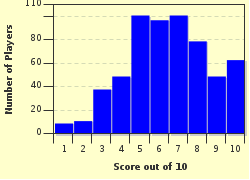Quiz Answer Key and Fun Facts
1. What designer's suspension system were incorporated in the T-34?
2. Besides the suspension system, what other innovation was used that greatly enhanced the T-34's defensive posture?
3. In what year was the T-34 put into production?
4. What was the initial caliber of the main gun of the T-34?
5. What German tank was designed as a direct response to the T-34?
6. What was a design drawback that the first T-34s encountered?
7. In what year did the T-34-85 Model 1943 first debut?
8. Which self-propelled gun used the T-34 chassis?
9. Approximately how many T-34s were produced?
10. As of 1996, how many countries still operated the T-34?
Source: Author
boxjaw
This quiz was reviewed by FunTrivia editor
bloomsby before going online.
Any errors found in FunTrivia content are routinely corrected through our feedback system.

